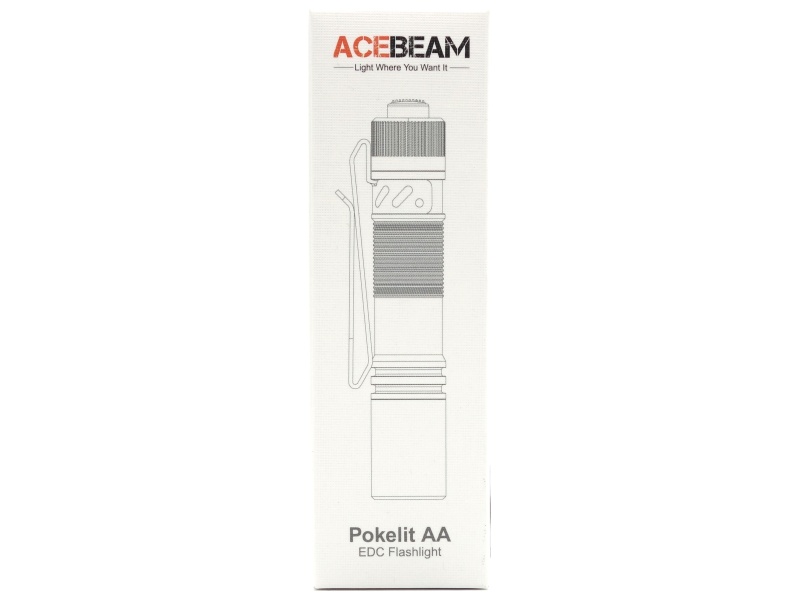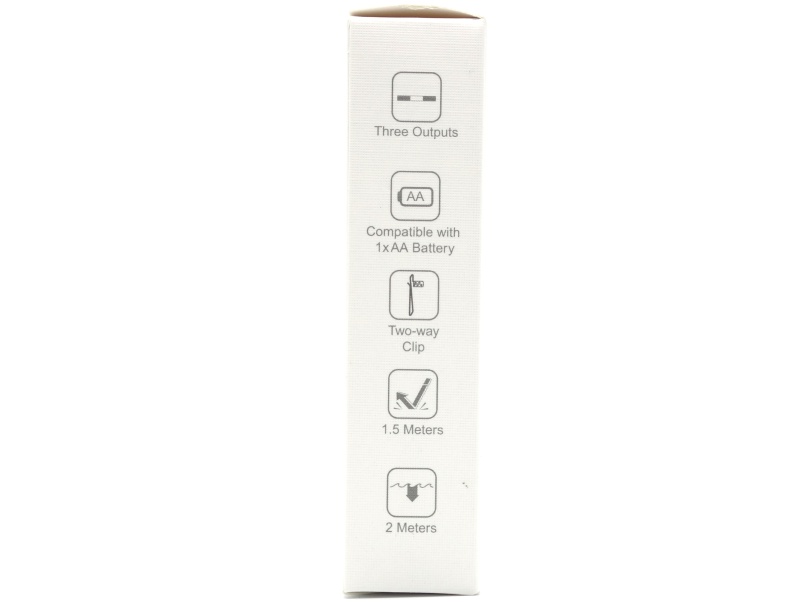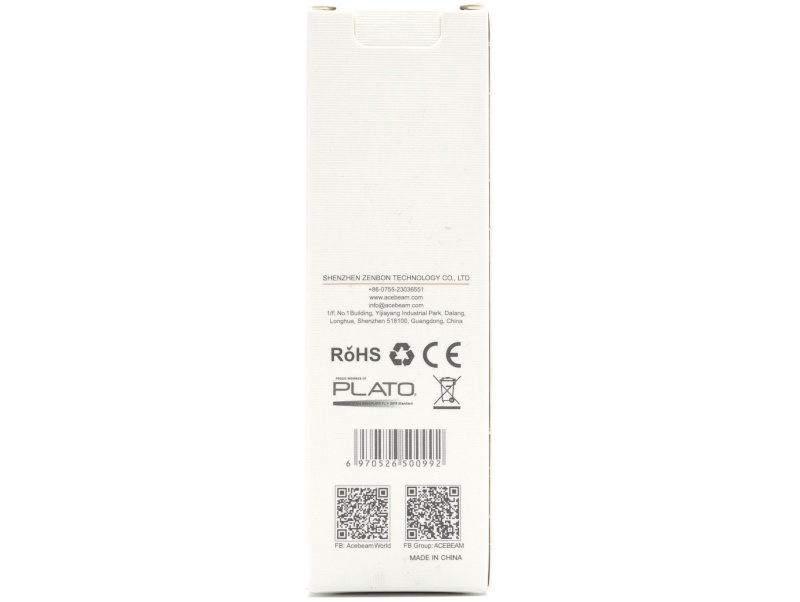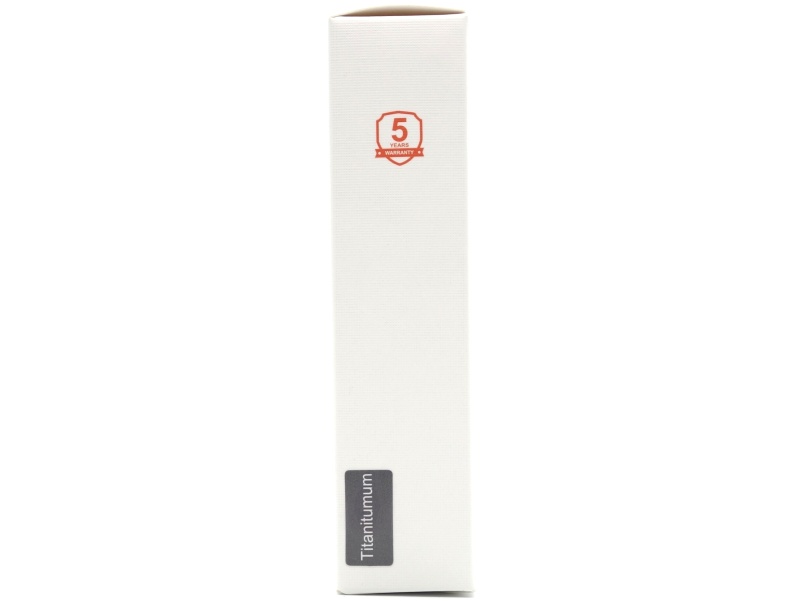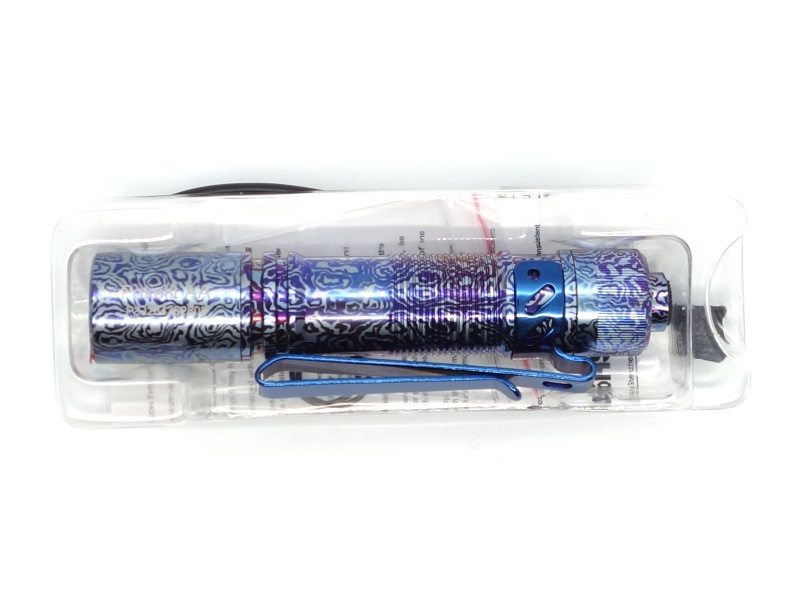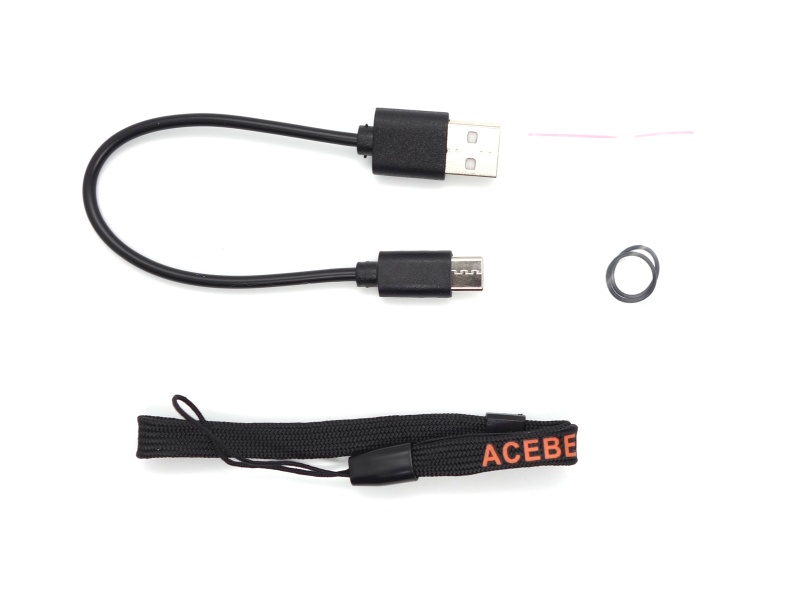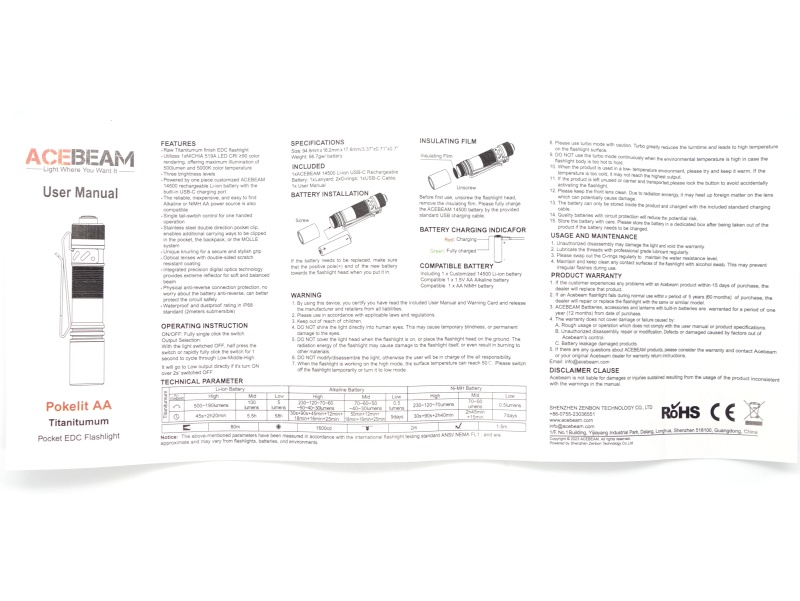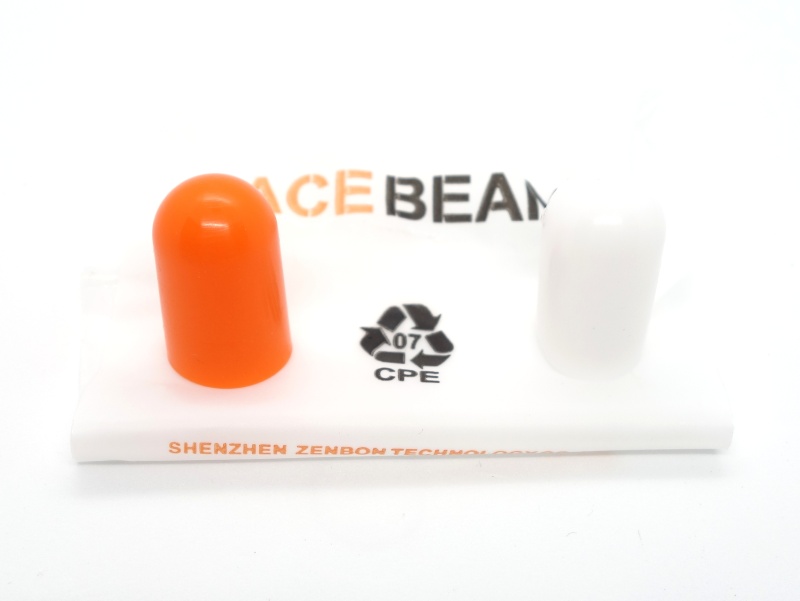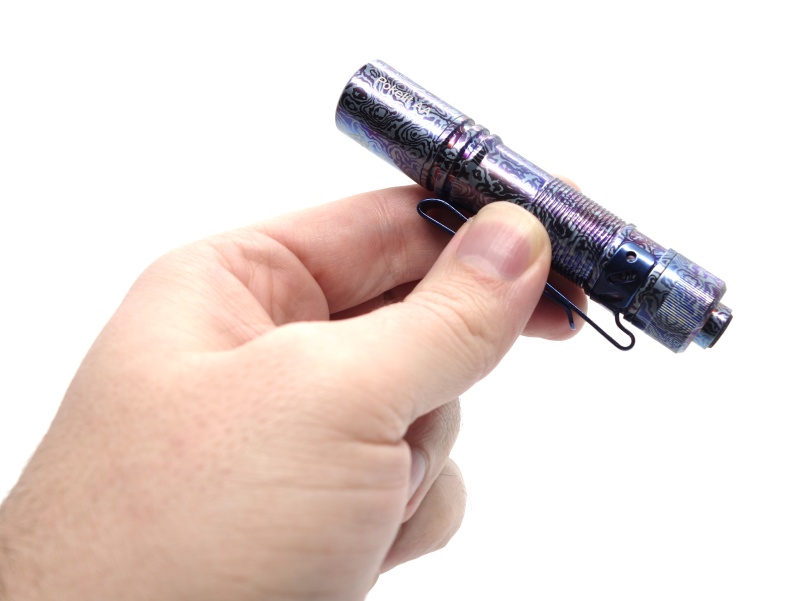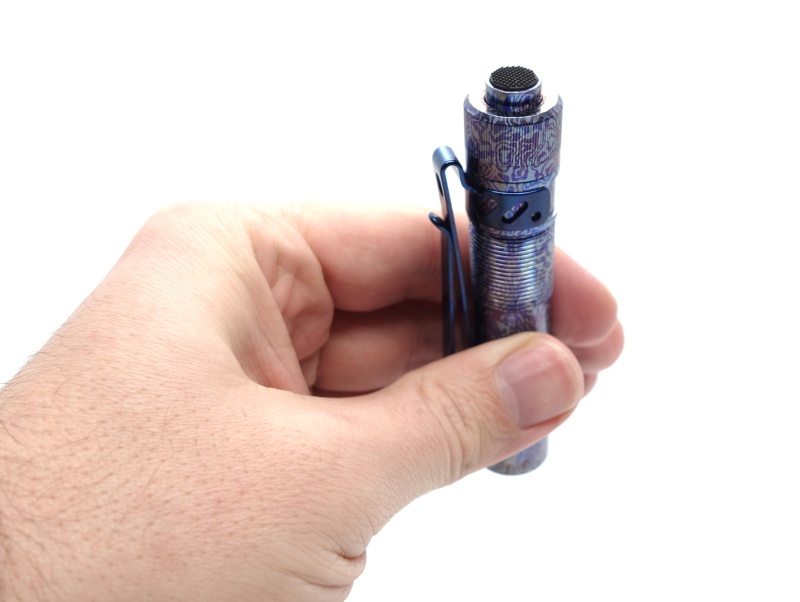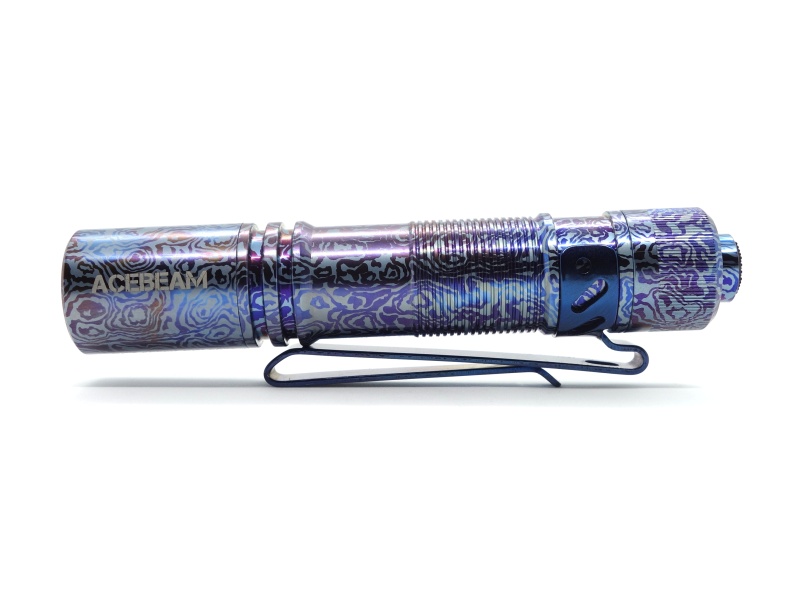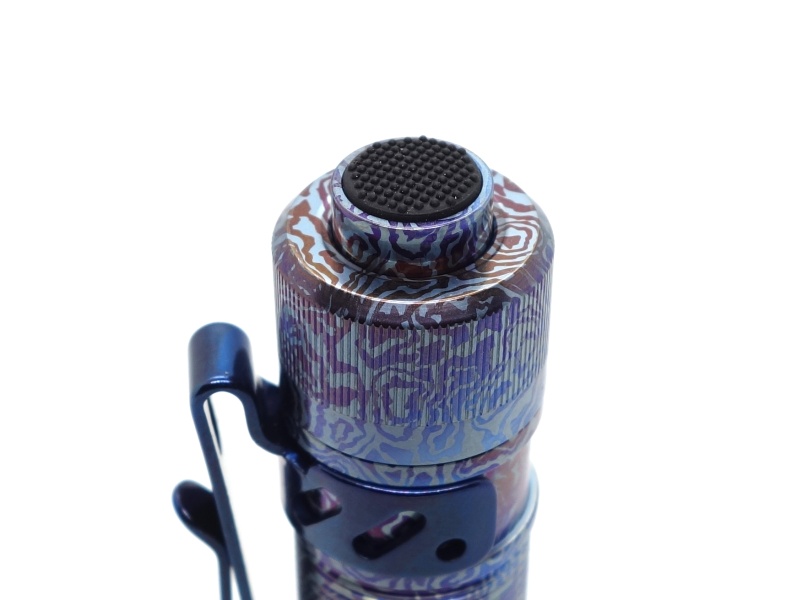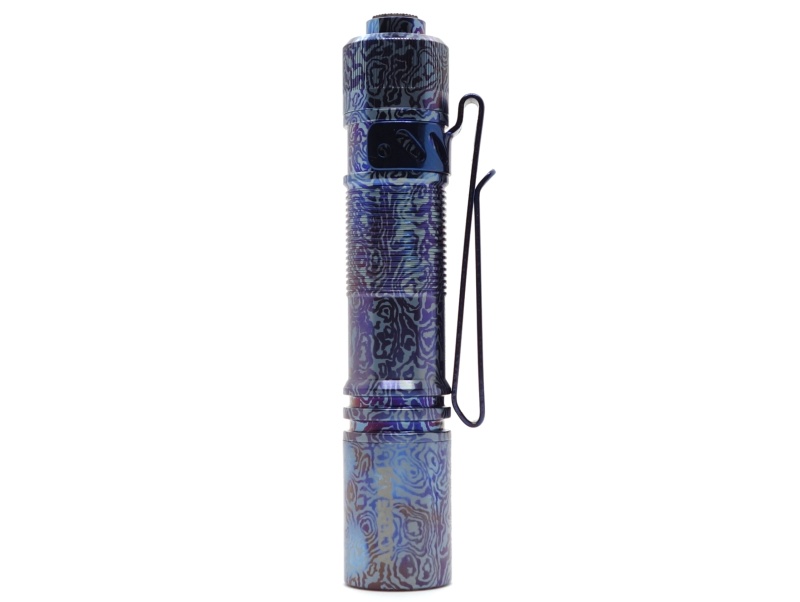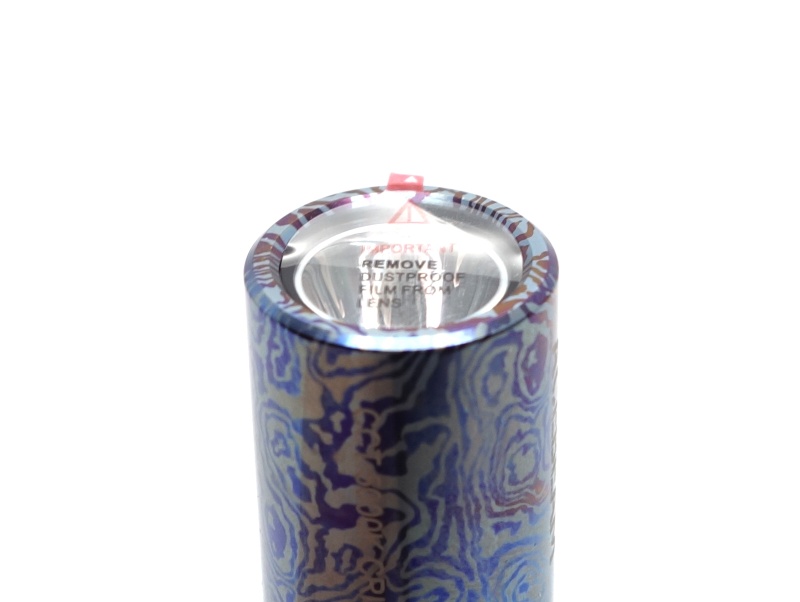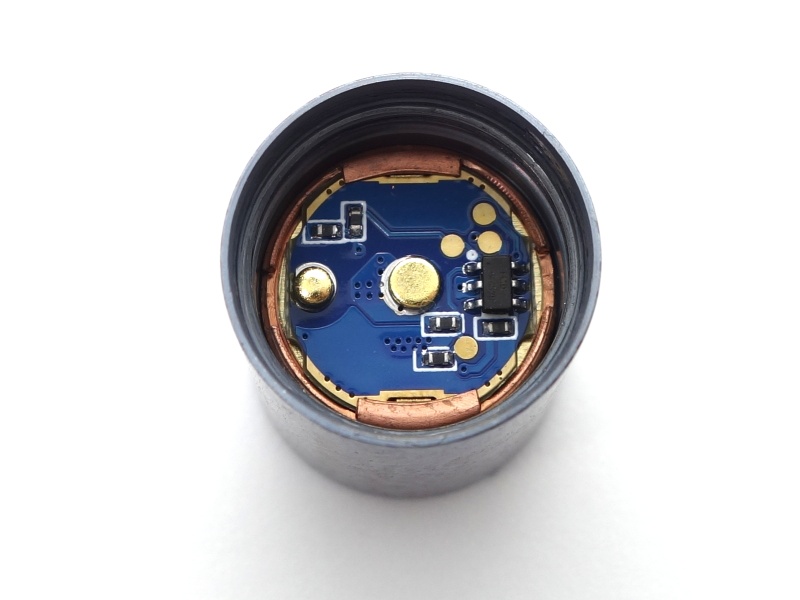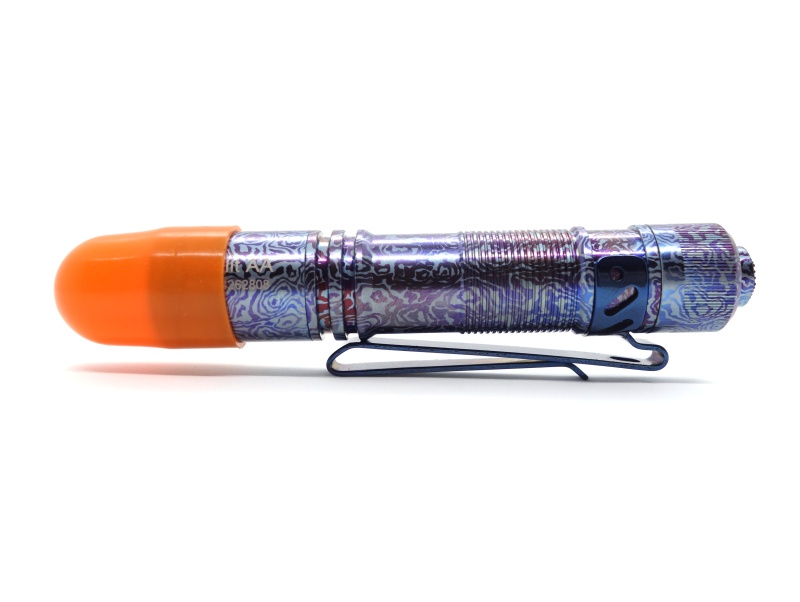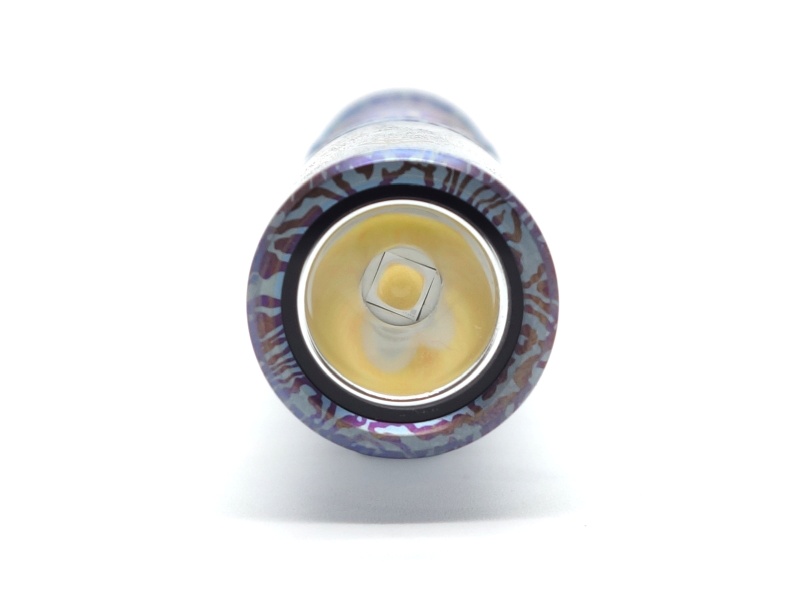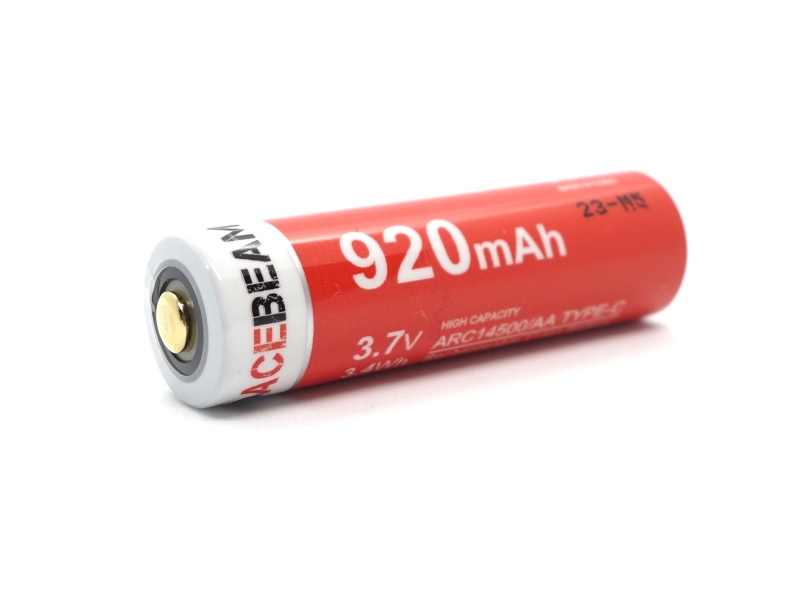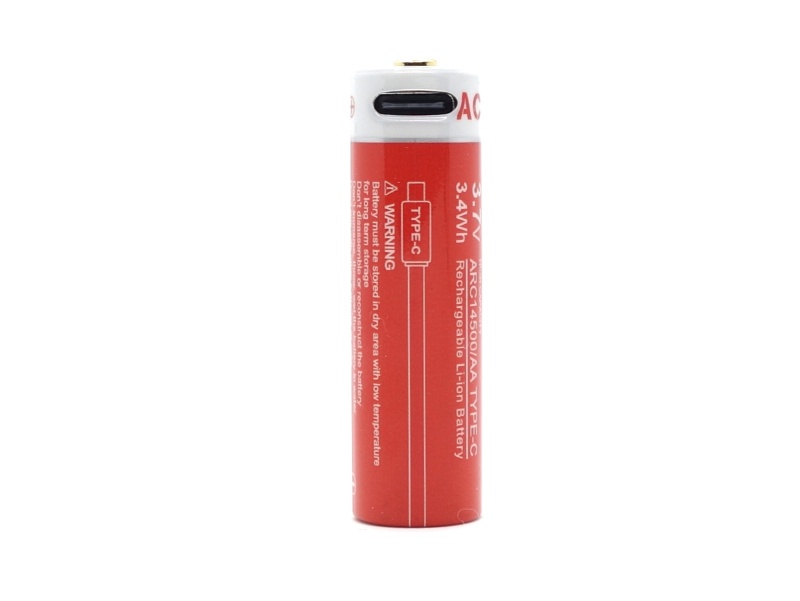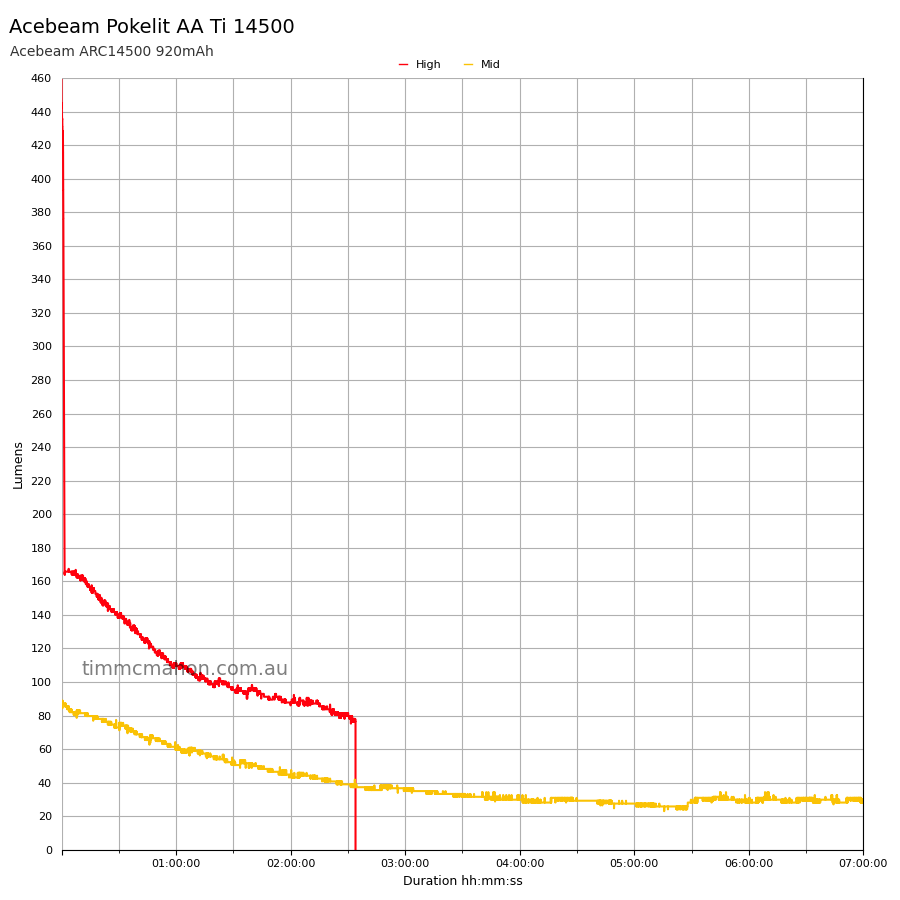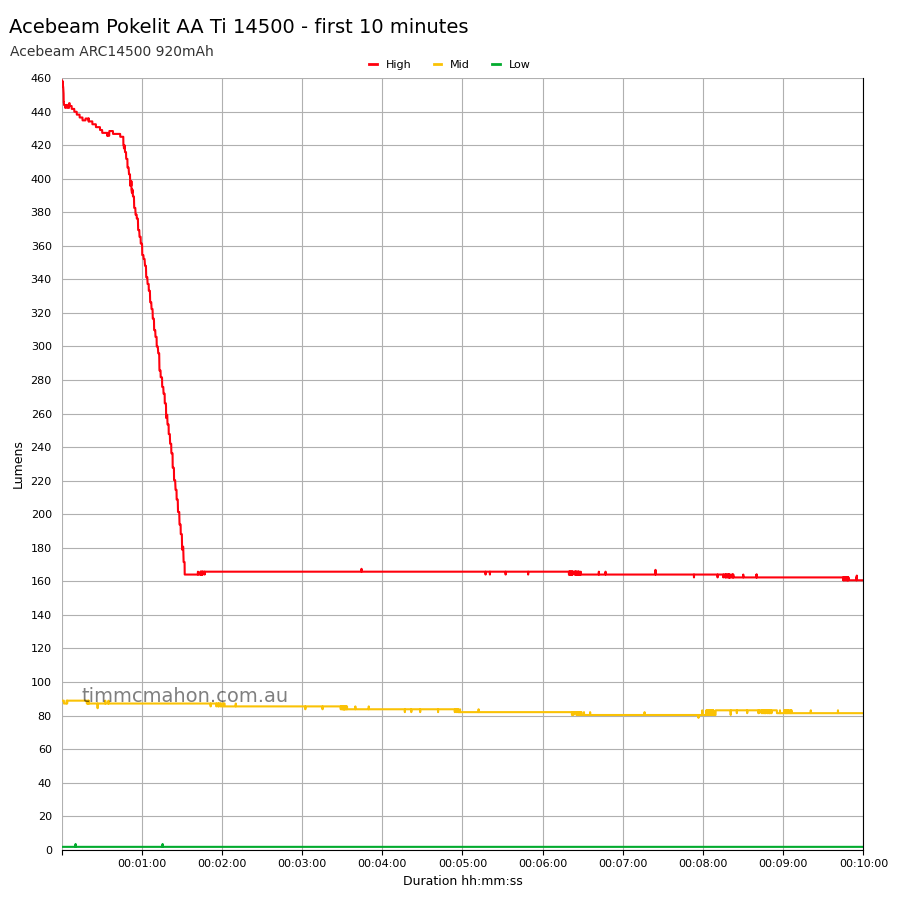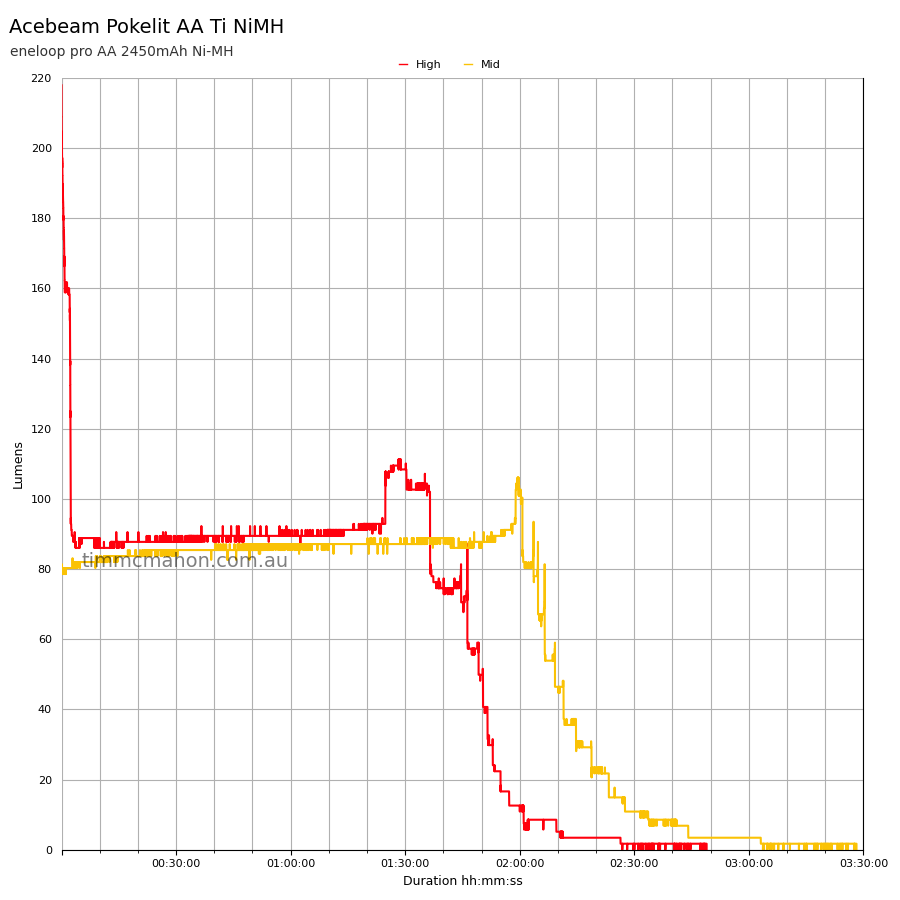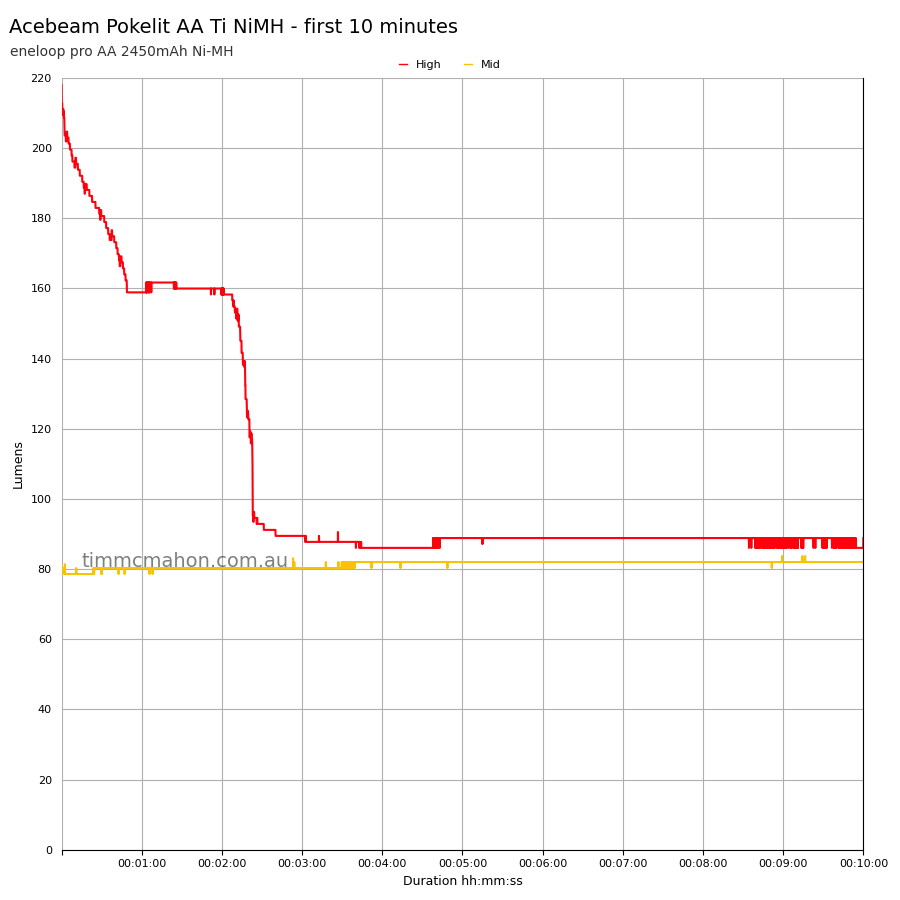Acebeam Pokelit AA Ti Torch Review
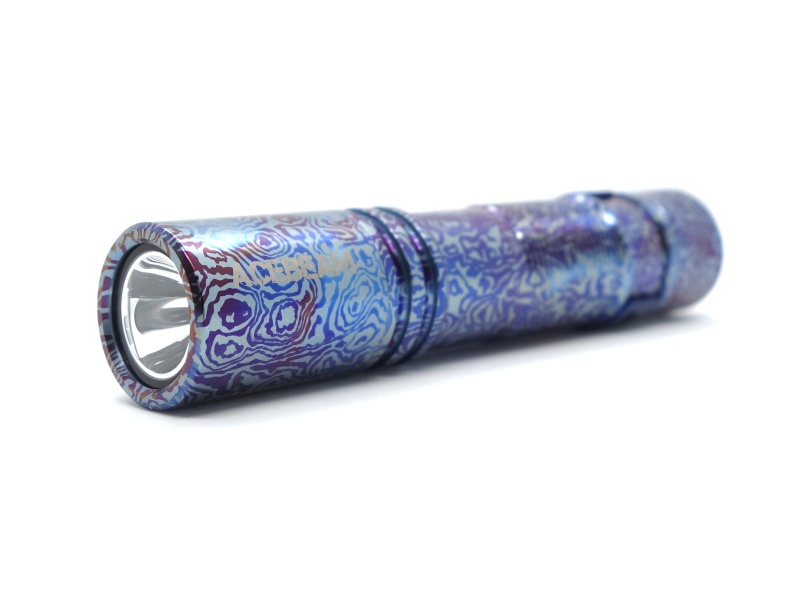
Acebeam Pokelit AA Ti⌗
- Specifications
- Introduction
- Torch in use
- Build quality
- LED, bezel, lens, reflector and beam
- Size and comparison
- User interface
- Batteries and charging
- Performance
- Beamshots
- Conclusion
- Price
- Product page
Specifications⌗
| Brand/model | Acebeam Pokelit AA Ti |
|---|---|
| LED | Nichia 519A 5000K CRI90 |
| Maximum lumens | 500 lm |
| Maximum beam intensity | 1,600 cd |
| Maximum throw | 80 m |
| Battery | 1*14500 Li-ion, 1*AA Ni-MH, 1*AA Alkaline |
| Onboard charging | Yes (USB-C battery) |
| Material | Aluminium |
| Modes | 3 |
| Blinkies | - |
| Reflector | Smooth |
| Waterproof | IP68 |
| Review date | September 2023 |
Introduction⌗
I get so excited over AA sized torches! So you can imagine how I felt when Acebeam showed me prototypes of the Pokelit AA while visiting them in May.
Acebeam teased the announcement of a new torch. I knew roughly what it would be but I didn’t know exactly what design they would choose.
When Acebeam announced the Acebeam Pokelit AA Ti, they kindly sent one for review.
The Acebeam Pokelit AA Ti is a forward-clicky AA sized torch with a what appears to be a blue topographical design. It has a high CRI Nichia 519A emitter and it can take Alkaline, Ni-MH or 14500 Li-ion cells.
There’s no mode memory! IYKYK.
I have not been paid for this review nor have I held back my opinions of this torch.
Packaging⌗
The Pokelit AA Ti came in a small white retail box.
The following was included in the box:
- Acebeam Pokelit AA Ti.
- Acebeam ARC14500 920mAh USB-C rechargeable battery.
- Lanyard.
- USB-A to USB-C cable.
- Two spare o-rings.
- User manual.
Optional orange and white diffuser caps (ASD-01) were included separately.
Torch in use⌗
The Pokelit AA Ti is relatively lightweight and fits comfortably in my hand.
I really like a forward-clicky tail switch on small AA sized torch.
The torch does not tail stand because there is a button sticking out at the end.
The included lanyard can be attached to the hole in the pocket clip.
The reversible pocket clip could be attached to a hat. There are some videos on TikTok with multiple Pokelit AA prototypes…
Build quality⌗
The Acebeam Pokelit AA Ti is made of titanium.
It has a finish that almost looks like a topographical pattern. There are swirls of dark blue with a light blue background. If I move the torch around under a light, the dark blue looks purple.
There is plenty of grip on the tube and the tail.
The button has titanium around the edges and rubber on the end. It isn’t one big squishy rubber button. It feels firm and it gives a satisfying click.
The threads turns smoothly but they feel slightly gritty. This is to be expected with titanium.
The pocket clip fits snugly on the tube. It can be rotated around the tube but it is difficult to remove.
The lens came with a protective film that needed to be removed before use.
There is physical reverse polarity protection on the driver for the battery. It appears to work.
Optional diffuser caps fit snugly onto the head of the Pokelit AA. It could be used as a mini traffic wand.
LED, bezel, lens, reflector and beam⌗
The Pokelit AA Ti has a Nichia 519A 5000K emitter with a smooth reflector and a glass lens.
The pill can be unscrewed to access the emitter. Some torch enthusiasts may want to de-dome the Nichia 519A emitter to make the CCT warmer and the duv negative (rosier).
CCT, CRI, and duv⌗
I have taken Correlated Colour Temperature (CCT) and Colour Rendering Index (CRI, RA of R1-R8) measurements with the headlamp positioned half a metre away from an Opple Light Master Pro III (G3). Low with a Ni-MH battery was measured at a distance of ten centimetres.
The CCT is around 4800K. The CRI is around 97.
The Delta u, v is slightly positive (green). I must have lost the tint lottery.
The beam produced has a circle that looks like a moon and a dim spill that extends around the circle.
| Cell | Mode | CCT (K) | CRI (Ra) | x | y | Duv |
|---|---|---|---|---|---|---|
| Ni-MH | Low | 4749 | 98.6 | 0.3540 | 0.3683 | 0.0048 |
| Ni-MH | Mid | 4810 | 97.9 | 0.3518 | 0.3654 | 0.0042 |
| Ni-MH | High | 4811 | 97.8 | 0.3516 | 0.3639 | 0.0035 |
| 14500 | Low | 4630 | 98.4 | 0.3574 | 0.3665 | 0.0027 |
| 14500 | Mid | 4885 | 97.7 | 0.3495 | 0.3652 | 0.0050 |
| 14500 | High | 4907 | 97.2 | 0.3485 | 0.3612 | 0.0034 |
Calculate Duv from CIE 1931 xy coordinates
Dimensions and size comparison⌗
Dimensions⌗
I took the following measurements using a digital caliper.
| Measurement | Unit (mm) |
|---|---|
| Length | 94.6 |
| Head outside diameter | 18.18 |
| Tube outside diameter | 16.95 |
| Tailcap outside diameter | 17.81 |
Weight⌗
I took the following measurements using a digital scale.
| Weight | Unit (g) |
|---|---|
| Torch | 46.42 |
| Battery | 20.88 |
| Torch with battery | 67.3 |
The aluminium version of the Pokelit AA is about 10 grams lighter.
Size comparison with its competition⌗
From left to right: Acebeam Pokelit AA Ti, Acebeam Pokelit AA Gray, Acebeam Pokelit AA Copper, Acebeam Rider RX Rainbow PVD, ReyLight LANapple Purple
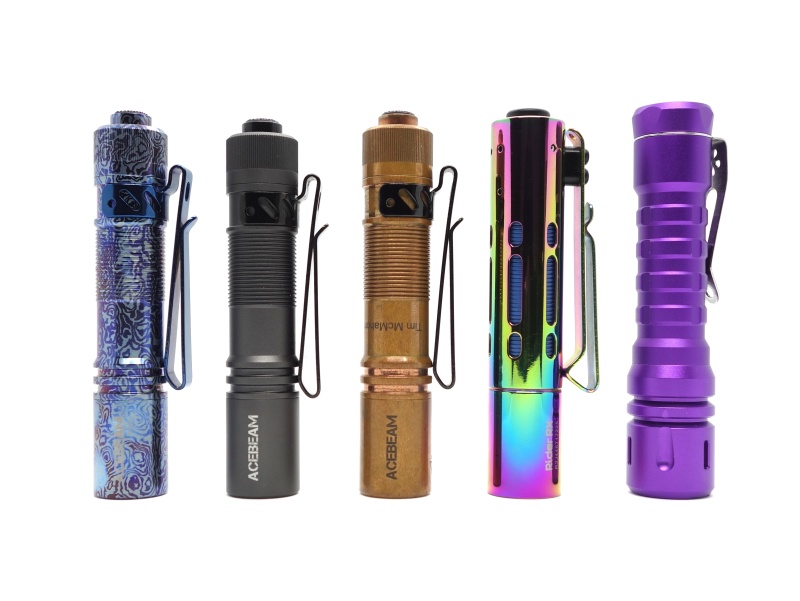
From left to right: Acebeam Pokelit AA Ti, Acebeam Pokelit AA Gray, Acebeam Pokelit AA Copper, Acebeam Rider RX Rainbow PVD, ReyLight LANapple Purple
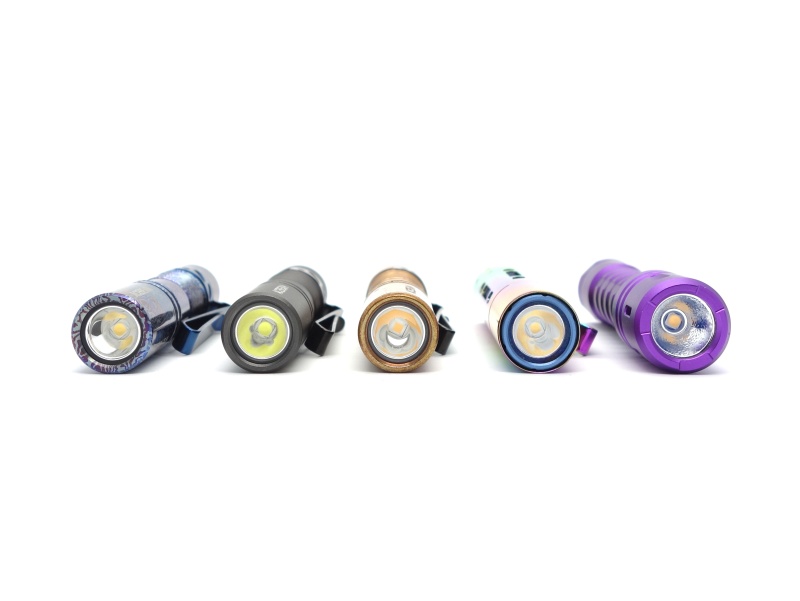
User interface⌗
A forward-clicky tail switch can be half pressed to momentarily turn the torch on and cycle between Low, Mid and High modes.
| State | Action | Result |
|---|---|---|
| Off | Half press | Momentary on (Low) |
| Off | Half press within 1 second | Cycle (Low, Mid, High) |
| Off | Click | On |
| On | Click | Off |
Mode memory⌗
The torch does not have mode memory. It will start on Low if the torch has been off for more than two seconds.
Low voltage protection⌗
I tested low voltage protection by connecting the driver of the torch to a bench power supply and then by lowering the voltage from 4.2V to 0V for a 14500 Li-ion cell, and from 1.5V to 0V for a Ni-MH cell.
There does not appear to be low voltage protection for a Li-ion cell built into the torch. The emitter turned off at 2.23V and the current dropped to 5 mA. This could be a problem if you use an unprotected button top Li-ion cell because it would slowly drain below 2.5V and damage the cell.
There is low voltage protection for a Ni-MH cell. The emitter turned off at 0.42V and the current stopped.
PWM⌗
I did not notice any visible PWM (flickering).
What I like about the UI⌗
- Simple to use.
- No mode memory.
The original Pokelit AA and Pokelit AA Gray have mode memory where it can be a bit unpredictable. Will it turn on in Low, Mid or High?
The Pokelit AA Copper was the first Pokelit AA to have no mode memory. It is great to see that the Pokelit AA Ti also has no mode memory.
What could be improved⌗
- I like it as it is.
Batteries and charging⌗
Battery⌗
The included Acebeam ARC14500 920mAh 3.7V Li-ion cell arrived with a voltage of 3.94V. It came with a bit of plastic at the end to prevent accidental activation while in transit.
The Pokelit AA Ti can take a Ni-MH 1.2V cell, Alkaline 1.5V cell or a 14500 Li-ion 3.7V cell.
Charging⌗
The included 14500 cell has USB-C charging built-in.
The same battery was included in the Acebeam Pokelit AA Gray. It took about 3 hours to charge from 3.00V to 4.18V at a rate of 5V 0.3A. The indicator light went from red to green when charging finished.
Power supply compatibility⌗
I tried the following power supplies with the built-in USB-C charger in the battery:
| Power supply | USB Type | Protocol | Does it charge? |
|---|---|---|---|
| Apple 61W Power Adapter | USB-C | PD | Yes |
| Google Pixel Power Adapter | USB-C | PD | Yes |
| PinePower Desktop | USB-C | PD | Yes |
| PinePower Desktop | USB-A | QC | Yes |
| PinePower Desktop | USB-A | Yes |
USB-C to USB-C charging works.
Performance⌗
Specifications from the manual:
Li-ion Battery (Acebeam ARC14500 920mAh)
| FL1 STANDARD | High | Mid | Low |
|---|---|---|---|
| Output (lumens) | 500 + 190 | 100 | 5 |
| Runtime | 45s + 2h 20min | 5.5h | 58h |
| Beam Distance (metres) | 80 | ||
| Beam Intensity (cd) | 1,500 |
Alkaline
| FL1 STANDARD | High | Mid | Low |
|---|---|---|---|
| Output (lumens) | 230 + 120 + 70 + 50 + 40 + 30 | 70 + 60 + 50 + 40 + 30 | 0.5 |
| Runtime | 30s + 90s + 45min + 12min + 18min + 16min + 25min | 50min + 12min + 18min + 16min + 25min | 9days |
| Beam Distance (metres) | |||
| Beam Intensity (cd) |
Ni-MH
| FL1 STANDARD | High | Mid | Low |
|---|---|---|---|
| Output (lumens) | 230 + 120 + 70 | 70 + 50 | 0.5 |
| Runtime | 30s + 90s + 2h 40min | 2h 45min + 15min | 7days |
| Beam Distance (metres) | |||
| Beam Intensity (cd) |
I used an eneloop pro AA Ni-MH 1.2V 2450mAh cell and the included Acebean ARC14500 Li-ion 3.7V 920mAh cell for the following tests.
The output drops six times for the High mode when using an AA Alkaline battery.
It would be awesome if Acebeam included a runtime graph in the user manual.
Lumen measurements⌗
I used a bench power supply to measure the current at turn on.
| Cell | Mode | Amps at start | Specs | Lumens @turn on | Lumens @30 sec | Lumens @10 min |
|---|---|---|---|---|---|---|
| Ni-MH | Mid | 0.01 A | 0.5 | |||
| Ni-MH | Mid | 1.08 A | 70 + 50 | 81 | 80 | 82 |
| Ni-MH | High | 4.06 A | 230 + 120 + 70 | 217 | 180 | 88 |
| 14500 | Low | 0.01 A | 5 | 1 | 1 | 1 |
| 14500 | Mid | 0.33 A | 100 | 88 | 87 | 81 |
| 14500 | High | 1.58 A | 500 + 190 | 458 | 428 | 253 |
Low with a Ni-MH cell is too low for my lumen tube to detect.
Standby drain⌗
There is no standby drain. This torch has a mechanical tailswitch.
Runtime graphs⌗
I used my own DIY lumen tube with a TSL2591 sensor and forked bmengineer’s project RuTiTe to record runtimes.
Note: Lumen measurements may be off by 10% with my DIY lumen tube.
The room temperature was approximately 15 C.
Runtime⌗
Here is a summary of the runtime results:
| Cell | Mode | User manual | Runtime | Turn off | Final voltage |
|---|---|---|---|---|---|
| 14500 | High | 45s + 2h 20min | 2h 34min 8s | 2h 34min 8s | 3.30 |
| 14500 | Mid | 5.5h | 7h+ | 7h+ | 3.21 |
| 14500 | Low | 58h | 10min+ | 10min+ | |
| Ni-MH | High | 30s + 90s + 2h 40min | 1h 55min 1s | 2h 48min 56s | 0.83 |
| Ni-MH | Mid | 2h 45min + 15min | 2h 41min 1s | 3h 28min 12s | 0.86 |
“Runtime” is the time until the output reduces to 10% of the output at 30 seconds (as per the ANSI/PLATO FL1 2019 Standard).
“Turn off” is the time until my DIY lumen tube no longer detects more than 1 lumen.
“+” indicates that the light remained on after recording had stopped.
I stopped recording after 10 minutes for the Low with a 14500 cell. I did not measure Low with a Ni-MH cell because it produces less than 1 lumen.
The runtime results are pretty close to Acebeams claim.
High and Mid lasted slightly longer than expected with a 14500 cell. But High fell short by almost an hour with a Ni-MH cell. Results could vary depending on the Ni-MH cell used and the temperature. The Ni-MH cells that I used are a few years old and it was a bit cold while testing so I expect there to be a slightly reduced capacity.
As you can see by the graphs, the light output drops as the battery voltage drops. In practice, this is okay for how I use the torch but it would be nice if the driver could provide a constant output like the drivers that Acebeam uses in their larger torches.
Throw⌗
I took lux measurements with a UNI-T UT383BT at 30 seconds. Each mode was measured at one metre.
| Cell | Mode | Specs (cd) | Specs (m) | Candela measured (cd) | Distance (m) |
|---|---|---|---|---|---|
| 14500 | Low | 4 | 4 | ||
| 14500 | Mid | 254 | 31 | ||
| 14500 | High | 1,600 | 80 | 1,289 | 71 |
| Ni-MH | Mid | 244 | 31 | ||
| Ni-MH | High | 505 | 44 |
Low with a Ni-MH battery was too low to detect at one metre.
Beamshots⌗
I went to a local park and aimed the Acebeam Pokelit AA Ti at a tree 70 metres away while using High.
Beamshots were taken using a Sony RX100M2 using 3.2", f3.2, ISO 100, 5000K WB.
Acebeam Pokelit AA Ti (High)⌗
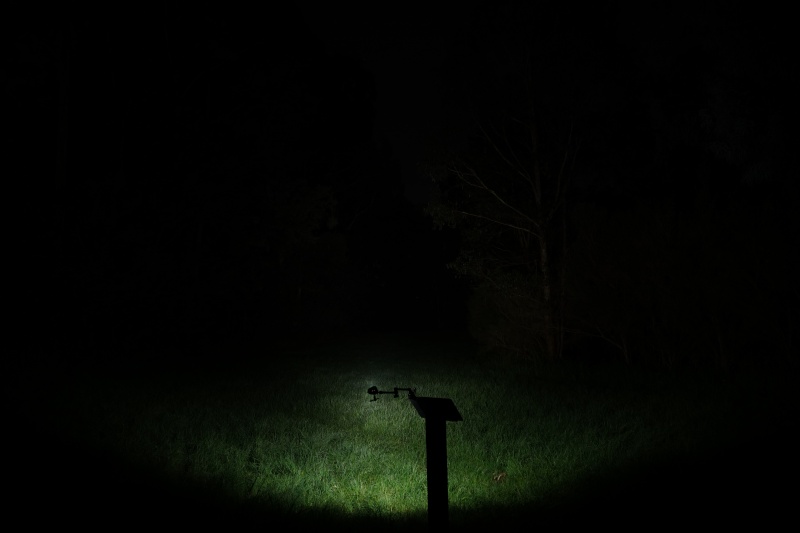
Acebeam Pokelit AA Gray (High)⌗

Lumintop EDC15 (Turbo)⌗

ReyLight LANapple (100%)⌗

Conclusion⌗
The Acebeam Pokelit AA Ti is a gorgeous EDC torch. There are light and dark blue topographical swirls. It is a perfect addition to a blue themed EDC.
I like how Acebeam has removed mode memory from the driver. It is nice to know that it will enter Low mode from off when coming back to it after a while.
There is a slight hint of green in the beam with this domed Nichia 519A 5000K emitter. I can fix this by unscrewing the pill and by removing the dome so that the beam becomes warmer and rosy. It would be nice if the beam was closer to pure white out of the box.
The included Acebeam 14500 Li-ion cell with built-in USB-C charging helps make this a complete kit.
The light output and beam distance was slightly lower than expected. It is still within the margin of error of my measuring equipment so I would take my results with a pinch of salt.
The runtime results were pretty close to what Acebeam claimed.
If you are a fellow enthusiast of AA torches then I can highly recommend the Acebeam Pokelit AA Ti!
Pros:⌗
- Excellent build quality.
- Simple UI.
- No mode memory.
- Good runtime.
- Battery with built-in USB-C charging.
Cons:⌗
- Slight hint of green in the beam.
- LVP did not work for an unprotected 14500.
- Slightly gritty threads (expected with titanium).
Price⌗
The Acebeam Pokelit AA Ti is AU$119.95 at the time of writing from liteshop.com.au and acebeam.com.au
I honestly think that this torch is underpriced for what it is.
Titanium torches with a nice design are usually more expensive than this.
Product page⌗
Promo code: SG9IP8YKT5PI
liteshop.com.au affiliate link
I may earn a commission if you use an affiliate link or a promo code. This will help fund future torch reviews and tutorials.
